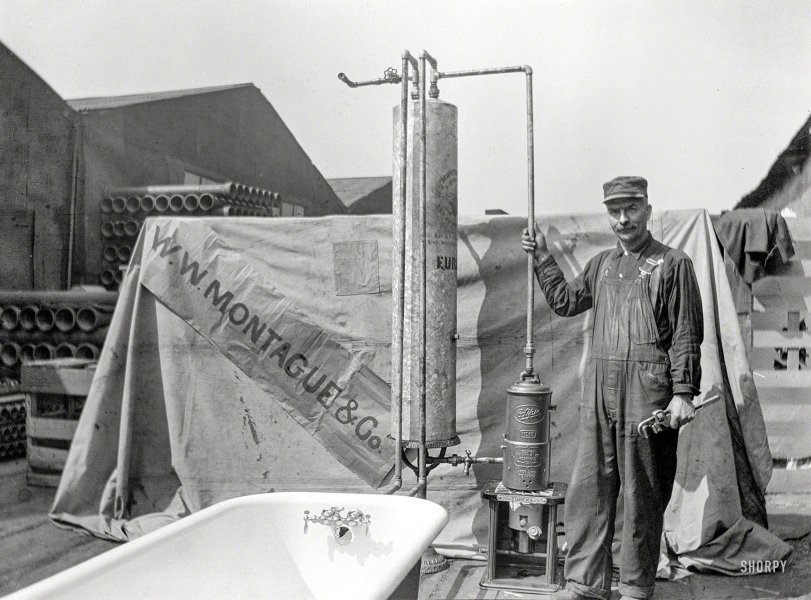


Framed or unframed, desk size to sofa size, printed by us in Arizona and Alabama since 2007. Explore now.
Shorpy is funded by you. Patreon contributors get an ad-free experience.
Learn more.

- Baldwin 62303
- Baldwin VO-1000
- Cold
- No expense spared
- Tough Guys
- Lost in Toyland
- And without gloves
- If I were a blindfolded time traveler
- Smoke Consumer Also Cooks
- Oh that stove!
- Possibly still there?
- What?!?
- $100 Reward
- Freeze Frame
- Texas Flyer wanted
- Just a Year Too Soon
- WWII -- Replacing men with women at the railroad crossing.
- Yes, Icing
- You kids drive me nuts!
- NOT An Easy Job
- I wonder
- Just add window boxes
- Icing Platform?
- Indiana Harbor Belt abides
- Freezing haze
- Corrections (for those who care)
- C&NW at Nelson
- Fallen Flags
- A dangerous job made worse
- Water Stop
Print Emporium
In Hot Water: 1910

San Francisco circa 1910. "W.W. Montague & Co. plumber with water heater and bathtub." 3x4 nitrate negative, photographer unknown. View full size.
We called them "jacket heaters"
When I was a kid in Montreal in the 1940s and '50s, we had this set-up in our kitchen; namely, an uninsulated (neither inside or out) hot water tank with a manufactured (not natural) gas-fired jacket heater. Natural gas would arrive late in the 50's and early '60s. Our war-widowed mother would light it with a wooden match; we would have to wait for the tank to warm up.
Once the bath night ritual was over, the jacket heater was shut down. An uninsulated water tank would have been prohibitively costly to keep going all the time. The only other time the heater was fired up was for washing clothes Mondays which were dried on the outdoor clothesline. I can still hear the squeaky pulley on the clothesline pole end. Sink washing for dishes and faces etc. were done with stove heated water only. In the bathroom, there was a large cast-iron enamel coated bathtub with claw and ball feet.
That tank did not hold much water; it barely covered the bottom of the tub. My mother supplemented the tank water with large containers of hot water heated on our gas stove. In the winter, when the coal stoves in the kitchen and dining room were being used, she boiled more water on top of them.
I, being 4 years younger than my sister, was the second into the tub on Saturday night. By then, the water had cooled off substantially; it was also scummy and dirty. We had no shower head. My mother did not believe showers were as cleansing a baths. I would most definitely not want to go back to that era bathing once a week. I now love showers!
W.W. Montague
This company is still around.
Old Apartment Plumbing
In 1967 I moved into a 1924 apartment building in Vancouver, B.C. The kitchen was original, and there were two separate taps (non-mixing) for hot and cold water. The hot was on the right and the cold on the left. The kitchen of the suite next door backed onto my kitchen, and the hot was on the left and the cold on the right. All the suites in the building had this arrangement. I guess it made installation easier for the plumbers in earlier days. There are a number of Internet suggestions for why the cold is on the right. The most common appears to be that early homes had a hand pump on the right, and as modern pressurized systems with hot and cold were installed, the cold stayed to the right.
Hot on the left, cold on the right
It appears that this practice had not yet been standardized in 1910, as the right knob is clearly plumbed into the hot water loop.
This is what is known as an indirect heater. They still exist today, although they are not very common. This one lacks a pump and thermostat. The burner has to be lighted and then stopped by hand, and the heated water circulates into the tank by thermosiphoning. It is highly unlikely that there is any safety valve.
The tank appears uninsulated, and there is probably no glass lining as on modern tanks, so its longevity would be in doubt. Of course there is no thought given to venting the exhaust outside, and not just because the photo shoot happened to be outside.
But so few homes had running hot water in 1910, this would have seemed an enormous leap to modernity for many.
I blame the parents
Who would name their son World Wide Montague?
W.W. Montague
Listing for the company in the 1908 Crocker-Langley City Directory:
"Importers and jobbers stoves, ranges, metals, mantels, tinners' stock etc. General offices SW corner Turk and Polk; Tile dept. 644 Polk; Furnace dept. 2270 Folsom; Factory 16th and Kentucky." ("Kentucky" is now Third St.)
No, no, Mr Montague
First the house, then the plumbing.
The first time I looked at this
I thought the tarp said www.montague.com
























On Shorpy:
Today’s Top 5